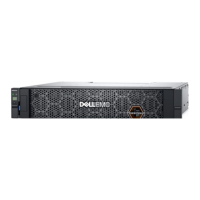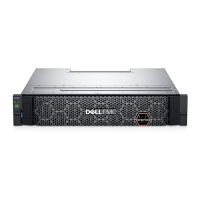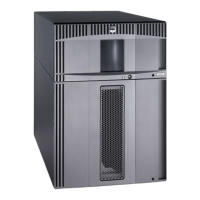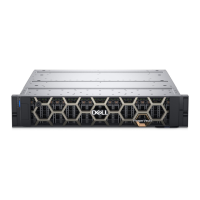Host-side connection troubleshooting featuring 10Gbase-T and SAS host
ports
The following procedure applies to ME5 Series controller enclosures employing external connectors in the host interface ports.
The external connectors include 10Gbase-T connectors in iSCSI host ports and 12 Gb SFF-8644 connectors in the HD mini-SAS
host ports.
1. Halt all I/O to the storage system.
2. Check the host activity LED.
If there is activity, stop all applications that access the storage system.
3. Check the Cache Status LED to verify that the controller cached data is flushed to the disk drives.
● Solid – Cache contains data yet to be written to the disk.
● Blinking – Cache data is being written to the controller module.
● Flashing at 1/10 second on and 9/10 second off – Cache is being refreshed by the supercapacitor.
● Off – Cache is clean (no unwritten data).
4. Remove the host cable and inspect for damage.
5. Reseat the host cable.
Is the host link status LED on?
● Yes – Monitor the status to ensure that there is no intermittent error present. If the fault occurs again, clean the
connections to ensure that a dirty connector is not interfering with the data path.
● No – Proceed to the next step.
6. Move the host cable to a port with a known good link status.
This step isolates the problem to the external data path (host cable and host-side devices) or to the controller module port.
Is the host link status LED on?
● Yes – You now know that the host cable and host-side devices are functioning properly. Return the cable to the original
port. If the link status LED remains off, you have isolated the fault to the controller module port. Replace the controller
module.
● No – Proceed to the next step.
7. Verify that the switch, if any, is operating properly. If possible, test with another port.
8. Verify that the HBA is fully seated, and that the PCI slot is powered on and operational.
9. Replace the HBA with a known good HBA, or move the host side cable to a known good HBA.
Is the host link status LED on?
● Yes – You have isolated the fault to the HBA. Replace the HBA.
● No – It is likely that the controller module needs to be replaced.
10. Move the host cable back to its original port.
Is the host link status LED on?
● Yes – Monitor the connection for a period of time. It may be an intermittent problem, which can occur with damaged
cables and HBAs.
● No – The controller module port has failed. Replace the controller module.
Isolating a controller module expansion port connection fault
During normal operation, when a controller module expansion port is connected to an expansion enclosure, the expansion port
status LED is green. If the expansion port LED is off, the link is down.
Use the following procedure to isolate the fault. This procedure requires scheduled downtime.
NOTE:
Do not perform more than one step at a time. Changing more than one variable at a time can complicate the
troubleshooting process.
1. Halt all I/O to the storage system.
2. Check the host activity LED.
If there is activity, stop all applications that access the storage system.
3. Check the Cache Status LED to verify that the controller cached data is flushed to the disk drives.
● Solid – Cache contains data yet to be written to the disk.
Troubleshooting and problem solving
41

